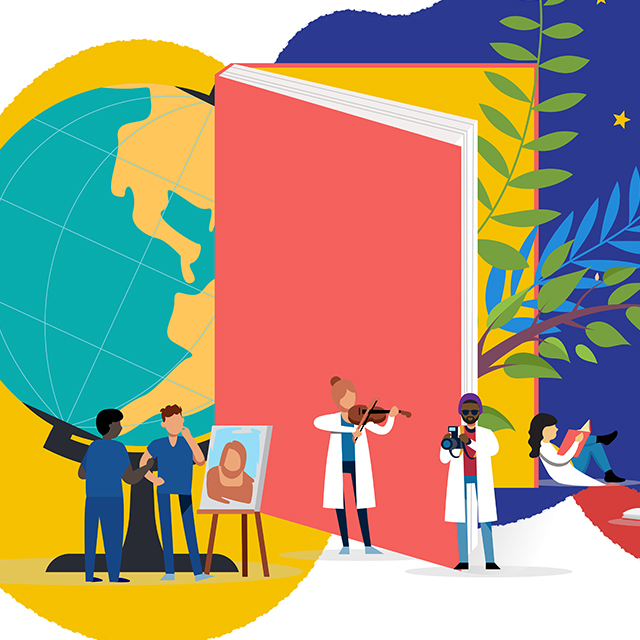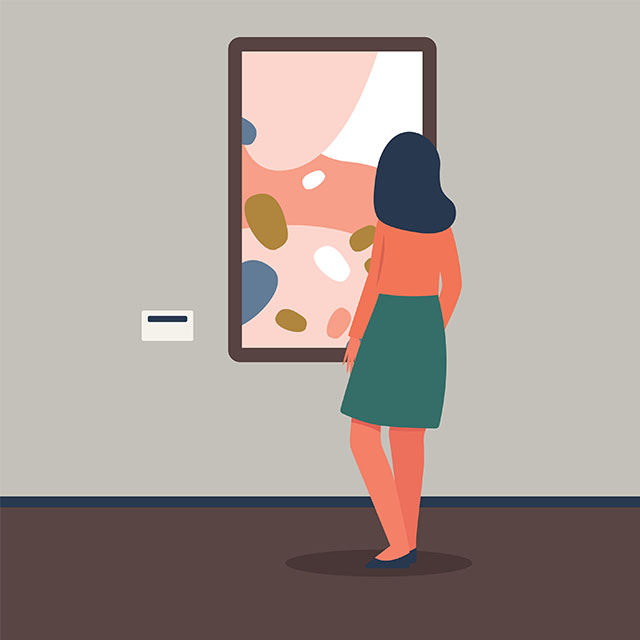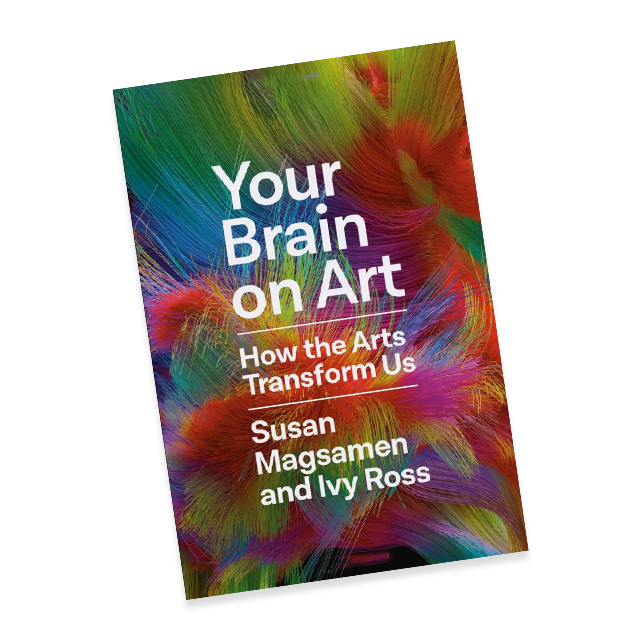In her final semester of medical school at Johns Hopkins, Mya Abousy (SOM ’23) was searching for a way to connect her interest in the arts with medicine when she decided to take an innovative humanities elective. One assignment required her to stroll through The Johns Hopkins Hospital as if she were visiting an art museum, then share her reflections.
The experience, part of the course Professional Identity Transformation, changed the way she thought about going to work.
“All of the art pieces people brought up in our discussion were ones I had never noticed in my four years walking the halls of that hospital,” Abousy says. “It was a reminder that when you slow down, you can find beauty in places where you really wouldn’t expect there to be much of it.”
She was particularly struck by a framed collage that presents a “very vibrant and colorful” image of the iconic John Hopkins Hospital dome.
“That piece of art romanticizes our workplace in a way that helped re-shape my perspective,” Abousy says. “It made me realize that if you depict your own life in a slightly different way than you’re used to, that newness can really spark a lot of inspiration.”
Now, as she heads off for her ophthalmology residency at the Bascom Palmer Eye Institute in Miami, Abousy credits the insights and self-awareness gained from the elective with helping to form and strengthen her identity as a physician.
“In a career that strives for efficiency, you want to see as many patients as you can, minimizing the amount of time you spend with each one so that you can provide more care to others in need,” Abousy says. “This course really reminded me that those extra breaths you can take with each of your patients will really help you humanize every situation.”
A Program for Flourishing
A four-week, highly interactive arts and humanities course for third-year and fourth-year medical students, Professional Identity Transformation, which takes place at the Baltimore Museum of Art and other local museums, introduces students to arts-based experiences in the community and clinical settings. In-person sessions are co-led by medical and museum educators.
Classes include discussions of visual art, music and poetry; sketching; mask-making and reflective writing. Each week centers on a core theme such as family, community and work/education.
Directed by Meg Chisolm, professor of psychiatry and behavioral sciences, the course uses “visual thinking strategies” — ways to observe, describe and interpret situations — that can stimulate nuanced perceptions and discussions not usually found in med school classrooms.
Her work leading the program is influenced by her role as director of the Paul McHugh Program for Human Flourishing, founded in 2015 at the Johns Hopkins University School of Medicine.
The word “flourishing,” which means to grow vigorously or to thrive, represents a powerful way to view health in its fullest sense, according to social scientist Tyler VanderWeele at the Human Flourishing Program at Harvard University’s Institute for Quantitative Social Science. His model of medicine and health incorporates happiness and life satisfaction, mental and physical health, meaning and purpose, character and virtue, close social relationships, and financial and material stability.
“Our program is focused mainly on education and helping medical learners at all levels to understand the relevance that ‘flourishing’ has to medicine,” Chisolm explains. “It’s important that we ask our patients about the pathways of flourishing — family, work, education and community — and that we also ask them about their social relationships, happiness, life satisfaction. All of this is relevant to their health and well-being.”
Chisolm says art-museum-based medical education is part of a larger movement to re-integrate the arts and humanities into medicine. A 2020 Association of American Medical Colleges report suggests that swift advances in science and technology have caused medical school curricula to focus increasingly on making sure students acquire specific knowledge and technical skills, without paying sufficient attention to the human and caring side of their training.
“We aim to help people reflect on the meaning of their work,” Chisolm says. “Medical students tend to get on the treadmill at a very young age — often in high school — and have a hard time getting off it.
“They are so focused on jumping through certain hoops, checking off boxes and fulfilling community volunteer experiences that they don’t stop to say, ‘What do I want out of this?’ After they’ve spent six or seven years preparing for this career, some people begin thinking, ‘I don’t know if this is for me.’”
Johns Hopkins medical student Diane Jung says she has asked herself those very questions. When she took Professional Identity Transformation last year, she attended sessions at a variety of Baltimore locations including the Cylburn Arboretum, the Rawlings Conservatory in Druid Hill Park, the Keystone Korner Baltimore jazz club, the Johns Hopkins Evergreen Museum and Library, and the Baltimore Museum of Art, the Walters Art Museum and the American Visionary Art Museum (AVAM).
“When I took the course, I was feeling very burned out and it helped me get out of that phase, reevaluate my values and reflect on my identity as a physician,” Jung says. “I think the course helped me re-commit to medicine.”
Jung mentions an assignment at AVAM in which two groups of students were instructed to study a painting of a young man’s face, develop a poem about it and discuss their reflections with their peers.
One group was told the face belonged to Dylann Roof, the white supremacist who murdered nine Black members of a church in Charleston, South Carolina, in 2015. The other students were not told anything about the person’s identity until a class discussion.
Jung was in the latter group.
“At first glance, the portrait seemed like just a regular face,” she says. “But both groups detected something disturbing.”
Although the poem that the uninformed students wrote was more empathetic, both poems found traces of anger, malice and hurt in the painting.
How did the exercise apply to the students’ sense of mission as doctors?
“We talked about what are the limits — if there are any — of empathy, and of our duty to treat people equally,” Jung says. “What would we do if we were tasked with treating a patient we knew committed a really atrocious crime?
“Although there were no concrete conclusions, it forced us to think about our duty as physicians. And using the art as a prompt made us engage with the issue in a way we wouldn’t have if someone just asked a theoretical question.”
Learning from Art
The course will be taught again this fall, and next spring, a full-semester version will be offered on the Homewood campus for upper level undergraduate students studying medicine, science and the humanities — a group that may pursue careers in the health professions.
Chisolm says many of the medical students who take the elective have rarely, if ever, ventured inside an art museum.
“There’s a lot of uncertainty and anxiety about what they’re supposed to do,” she says. “We point out that we’re not typically learning about art — we’re learning from art.
“In order to provide more humanized care, we have to be more human ourselves. Our encounters with art help us to be better doctors and give us insights that will help our patients lead meaningful and purposeful lives.”




